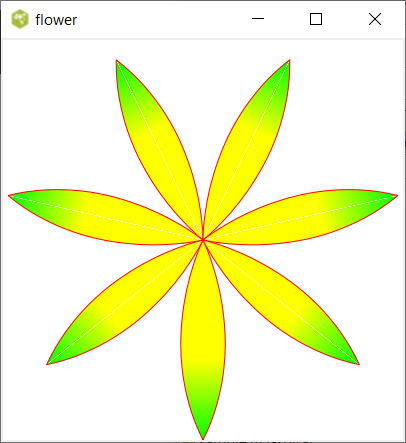Drawing a flower with Blend2d
Arjen Markus (16 july 2024) With the new version of Blend2d that was published a few days ago I experimented a bit with the various geometries and other features. Notably:
- A path object (I led myself be inspired by one of the examples) that contains a canonical petal
- Various transformations, among which a rotation over 360/7 degrees to achieve a flower with seven petals
- A colour gradient, just for good measure.
The code:
# flower.tcl --
# Draw a simple flower using a single petal.
# Use the transformation matrix to rotate it about the centre.
# For good measure add a colour gradient.
# The trick is to realise how the transformations are applied.
#
# Note: I know of no natural flower that has seven petals, so
# as far as I am concerned this is a completely new species.
#
set thisDir [file normalize [file dirname [info script]]]
set auto_path [linsert $auto_path 0 [file dirname $thisDir]]
# --flower - demo
package require Blend2d
set sfc [image create blend2d -format {400 400} ]
label .x -image $sfc ; pack .x
$sfc clear -fill.style 0xFFFFFFFF
set petal [BL::Path new]
$petal moveTo {0 0}
$petal cubicTo {0 0} {0.25 0.5} {0 1}
$petal moveTo {0 0}
$petal cubicTo {0 0} {-0.25 0.5} {0 1}
set transform [Mtx::MxM [Mtx::scale 200 200] [Mtx::translation 200 200]]
set rotation [Mtx::rotation [expr {360.0/7.0}] degrees]
$sfc applyTransform $transform
for {set n 0} {$n < 7} {incr n} {
#
# For a uniform colour:
#
# $sfc fill $petal -fill.style 0xFFFFFF00
#
# Use the gradient:
#
set gradient [BL::gradient LINEAR {0.0 0.0 0.0 1.0} [list 0.0 [BL::color yellow] 0.6 [BL::color yellow] 1.0 [BL::color lime]]]
$sfc fill $petal -fill.style $gradient
$sfc stroke $petal -stroke.style 0xFFFF0000 -stroke.transformorder BEFORE
$sfc applyTransform $rotation
}
$petal destroyAnd the resulting picture:
This can actually be improved:
- The petals show a thin yellow line in the middle. Redefining the path object eliminates that (see below).
- The gradient needs to be computed once only, so you can move the computation out of the loop.
The path is better defined in this way:
set petal [BL::Path new]
$petal moveTo {0 0}
$petal cubicTo {0 0} {0.25 0.5} {0 1}
# Original:
#$petal moveTo {0 0}
#$petal cubicTo {0 0} {-0.25 0.5} {0 1}
# Improvement: reverse the order of the points
$petal cubicTo {0 1} {-0.25 0.5} {0 0}Note: It may not be immediately clear. but the transformations are stacked and then applied last one first. For this reason adding a rotation over 360/7 degrees each iteration leads to the petals being rotated in steps over 360/7 * n degrees.
